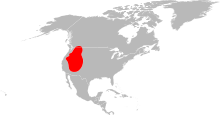Dermacentor andersoni
| Rocky Mountain wood tick | |
|---|---|
| Scientific classification | |
| Kingdom: | Animalia |
| Phylum: | Arthropoda |
| Class: | Arachnida |
| Subclass: | Acari |
| Superorder: | Parasitiformes |
| Order: | Ixodida |
| Family: | Ixodidae |
| Genus: | Dermacentor |
| Species: | D. andersoni |
| Binomial name | |
| Dermacentor andersoni Stiles, 1908 | |
 | |
Dermacentor andersoni, commonly known as the Rocky Mountain wood tick, is a species of tick.[1] It can cause tick paralysis. This tick is well known as a vector of the Rocky Mountain spotted fever rickettsia in the northwestern U.S. and Canada, the Colorado tick fever virus, and the bacteria which causes tularemia (hunter's disease).[2]
Diagnostic features:
- The larva only has three pairs of legs.
- The nymph has four pairs.
- A single pair of spiracular openings (stigmata) are seen close to the coxae (leg bases or segments) of the fourth pair of legs (except in larvae).
- A terminal capitulum (mouthparts) is visible from above in all hatched stages.
- A large sclerite called the scutum is present dorsally behind the capitulum. The scutum almost entirely covers the back of the male, but only partly covers the back of the female.
- Eyes, if present, are on the scutum.
- Sexual dimorphism in size and colour is frequent. The female is often larger.
- The posterior margin of opisthosoma is usually subdivided into sclerites called festoons.
- The pedipalps are rigid along the chelicerae, and are not leg-like.
See also
References
- ↑ Dergousoff SJ, Gajadhar AJ, Chilton NB (March 2009). "Prevalence of Rickettsia species in Canadian populations of Dermacentor andersoni and D. variabilis". Appl. Environ. Microbiol. 75 (6): 1786–9. doi:10.1128/AEM.02554-08. PMC 2655481
 . PMID 19151178.
. PMID 19151178. - ↑ http://entomology.ucdavis.edu/Faculty/Robert_B_Kimsey/Kimsey_Research/California_Ticks/
This article is issued from Wikipedia - version of the 9/3/2016. The text is available under the Creative Commons Attribution/Share Alike but additional terms may apply for the media files.